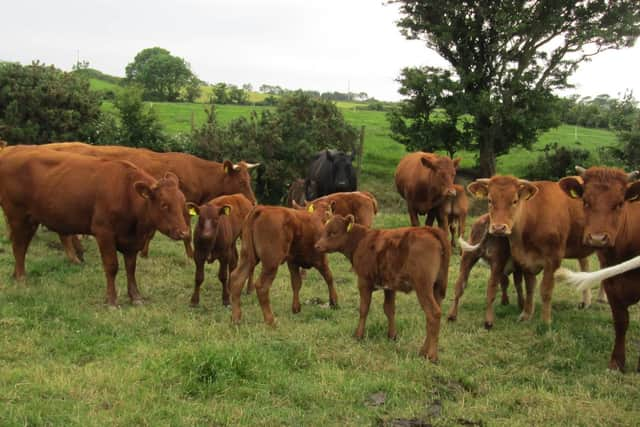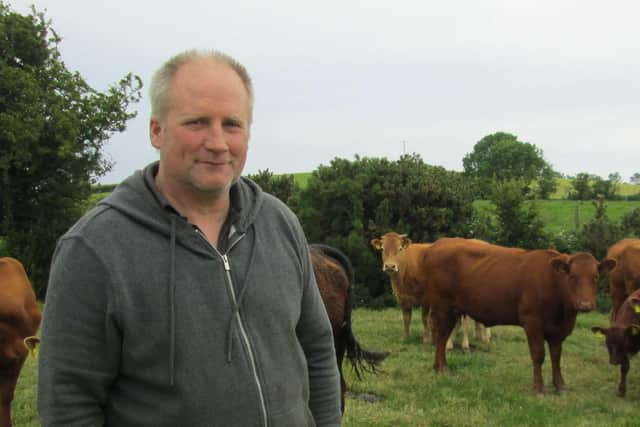Suckler farmer adopts new technologies
and live on Freeview channel 276
The benefits of accelerated genetic improvement within the breeding herd and the commercial availability of female sexed semen from maternal beef sires are making this a viable option for many.
Colin McEvoy, College of Agriculture Food and Rural Enterprise (CAFRE) Beef and Sheep Adviser caught up with one such farmer who is embracing this new technology is John Cultra.
Advertisement
Advertisement
Sexed semen in comparison to conventional semen is more expensive but carries many advantages. For John there is one major advantage which makes using sexed female semen a good fit for his farm; the ability to target maternal and terminal genetics to certain breeding stock.


Whilst operating his closed herd policy in conjunction with sexed female semen, John now does not need to breed as many of his herd to a maternal bull as the probability of a heifer calf from sexed semen is greatly increased. This in turn allows for more of the herd to be bred to terminal sires while still maintaining the required number of replacement females being born.
The cows which are bred to terminal sires can be individually selected for artificial insemination or natural service to terminal sires with superior growth and carcase traits, resulting in higher performing calves which in turn should increase the output from the herd.
In addition, the use of sexed semen and novel synchronisation programs has helped John to breed a compact batch of future replacement heifers. These heifers will be calving down sooner at the start of the season than when compared to using conventional semen or the stock bull.
Advertisement
Advertisement
Sexed semen does come with its challenges, with one seen on farm being the potential for lower conception rates compared to conventional semen. To maximise conception rates it is important to pay particular attention to straw handling and AI procedure at the time of breeding.


On the Cultra farm, the use of sexed semen was prioritised on maiden heifers as they are generally more fertile and should have higher conception rates when compared to cows. In John’s case ten maiden heifers were synchronised and served via fixed time AI (FTAI) with female sexed semen.
Six heifer calves were born to this first service, resulting in a conception rate of 60%. By opting to use sexed female semen John noted that birth weights were lower, aiding calving ease on these heifers which were calving for the first time at 24 months.
John has seen first-hand the benefits of using sexed female semen this year commenting that any suckler farmer who uses AI could also see the benefits.
Advertisement
Advertisement
If planning to use this technology, there a few things worth considering:
· Research what female sexed sires are available to suit your needs. Are they well proven with high accuracies? what cost is the straw? and when can the straws be delivered?
· Decide if the semen is to be used on cows or heifers, is it suitable for maiden heifers?
· Ensure all intended vaccinations are administered, veterinary checks carried out and dosing is completed.
Advertisement
Advertisement
· Forward plan feeding requirements. Are all animals to be served on a good and rising plane of nutrition. If serving maiden heifers, have they met their target service liveweight and age? 60% of mature weight at service.
· Record details of those animals seen cycling already and monitor if they are cycling regularly.
· Consider whether these animals will be served on observed heats or synchronised. If synchronising, plan it out, discuss with your vet and AI technician if using one.
· If DIY AI, ensure AI protocol is of a high standard in terms of semen handling, thawing and insemination timing/technique
o Pre warm insemination guns to body temperature
o Thaw straws at 35 -37 C for 45 seconds
Advertisement
Advertisement
o Complete insemination confidently and promptly within 5 minutes
o Ensure adequate and proper handling facilities are available to reduce stress on the animals being served
o Restrain animals to be served prior to thawing the straw
o When heifers are to be inseminated with sexed semen after observed heats, AI should be conducted 14-20 hours after the onset of heat.
· Keep handling and stress on the animals to a minimum after service and maintain a good plane of nutrition post service
Advertisement
Advertisement
· Plan to observe for repeats and consider using heat detection aids such as tail paint
In conclusion, John plans to use sexed semen this year again allowing him to continue producing female replacements from high genetic merit maternal bulls mated with the best maternal females in his herd.
With the variability in conception rates, he relies on an experienced, competent AI technician to carry out the AI procedure. He is also careful in his animal selection, animal nutrition; pre and post service and animal handling; during and after service.
Although the use of sexed semen has added extra expense to the system it gives John greater control allowing him the opportunity to choose the calf sex which can have a huge benefit within his breeding strategy.